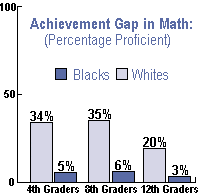 | |||||||||
| |||||||||
|
|||||||||
Act's Final Regulations Reaffirm Parent Options
NCLB: A Year in Review
Close-Up: No Child Left Behind—Faith-Based Efforts
Tips for Parents
New Guidance on Parent Options
Act's Final Regulations Reaffirm Parent Options
On November 26, the U.S. Department of Education released final regulations for the No Child Left Behind Act (NCLB), reiterating the range of options that parents with children in disadvantaged schools can exercise under the new law.
The final regulations follow nearly a year of extensive outreach the Department undertook to solicit public input since the signing of the bill on January 8, 2002. The regulations clarify federal, state and local responsibilities under the act for ensuring that parents have better and expanded learning opportunities for their children in Title I schools.
Among significant policies, states and school districts are responsible for ensuring that the list of approved supplemental educational service providers (organizations providing extra academic help) include some providers that can serve students with limited English proficiency and students with disabilities.
Additionally, in an effort to ensure school choice, the law prohibits a school district from precluding choice options due to over-capacity at preferred schools. The choice option must begin as soon as possible after a school is identified as "in need of improvement."
The regulations, published in the Federal Register last month, also cover teacher quality and accountability provisions of the law. For a copy, please visit www.ed.gov/programs/titleiparta/legislation.html#reg.
NCLB: A Year in Review
By Rod Paige, Washington, D.C.
Marking the first anniversary of the signing of the No Child Left Behind Act, U.S. Secretary of Education Rod Paige reflects on this year's developments regarding the historic law.
One year has passed since President Bush signed the No Child Left Behind Act, and it has not passed quietly. It has been a busy year for all of us, and we have made some real progress toward ensuring that all of our children receive a great education.
In January, our Department hosted an historic summit with state education officials at Mount Vernon. Throughout the year, I traveled the country and heard many stories of teachers, administrators and parents working together to ensure that all children succeed. We have already begun meeting with states individually to make sure we live up to the bipartisan vision of No Child Left Behind.
The first year under this new law has brought with it many accomplishments. Twenty states have received Reading First grants totaling more than $412 million. These grants support critical improvements in classroom reading instruction based on proven methods of instruction, screening and diagnosis of reading difficulties, monitoring of student progress, and thorough and high-quality professional development for teachers.
| "There is no great society which is not a caring society. People who don't have hope can find hope, people who wonder about the American Dream will realize the American experience is meant for them. And one way to ensure that is to unleash the armies of compassion that exist all across the country. As far as I'm concerned, the federal government will be a welcoming agency. We will allow faith-based programs to compete, side-by-side, with secular programs, all aimed at making sure America is the greatest country possible for every single citizen." —President George W. Bush |
We have hosted policy-makers and key education leaders from every state and territory in the nation at three Reading Leadership Academies, designed to help state leaders gear up for swift and successful implementation of Reading First. We are on our way to reaching the president's goal of having research-based reading programs in every classroom in America.
This year also brought the release of a nationwide list of schools classified by their states as "in need of improvement." They are schools that can improve and live up to their full potential-providing a quality education to every child who walks through their doors. Knowing where these schools are and helping them turn around are the first steps toward true accountability in public education, which is required by the new law.
Since No Child Left Behind was signed one year ago, the Department has also worked with schools on dealing with safety issues. We have begun work on overhauling state teacher certification systems. We have seen the Supreme Court clear the way for school choice. We have highlighted the research on character education through the Conference on Community and Character hosted by First Lady Laura Bush. We have launched a State Scholars Initiative to encourage high school students to take more challenging course work and better prepare themselves for higher education and a brighter future. We have also focused on our youngest children by working with the states to ensure that preschool children are ready to learn when they start school.
We are still at the beginning of implementing the 12-year plan of No Child Left Behind. We will continue to build on the foundation, and together, we will address many other challenges and opportunities in the coming years.
Close-Up On: No Child Left Behind—Faith-Based Efforts
The No Child Left Behind Act of 2001 recognizes that the vast network of parents and community members involved in faith-based and community activities are quiet heroes who bring hope and opportunity to people's lives in ways that are beyond the federal government's ability.
Through Title I, Part A, of the law, which is intended to help ensure that all children have the opportunity to obtain a high-quality education, faith-based organizations (FBOs) are eligible to apply for approval to provide supplemental educational services to low-income students attending chronically underachieving schools.
Supplemental services must be made available to students from low-income families who attend schools that are in their second year of "needing improvement." These services provide extra help before or after school, on weekends or during the summer, in reading, language arts and math.
On December 12, President Bush unveiled a new guidance clarifying that faith-based and community groups may provide services to these students as long as the FBOs meet the criteria for approval and comply with legal requirements for receiving government funds. The guidance states that:
- State education agencies, responsible for determining the list of eligible providers, may not discriminate against potential supplemental services providers with regard to religion or any other factor.
- FBOs that receive funding to provide supplemental services may maintain their religious character and identity, but may not discriminate against beneficiaries based on religion or any other factor.
- Federal funds may not be used to support religious practices, such as religious instruction, worship or prayer. FBOs may offer such practices, but not as part of the NCLB supplemental educational services.
 Source: The Nation's Report Card, National Center for Education Statistics, 2000. |
Tips for Parents!
Parents, you can help your children be ready to read and ready to learn simply by:
- Reading to your baby every day. Hearing words over and over helps your child become familiar with them.
- Using sounds, songs, gestures and words that rhyme to help your baby learn about language and its many uses.
- Pointing out the printed words in your home and other places you take your child, such as the grocery store.
- Taking children's books and writing materials with you whenever you leave home.
- Creating a quiet, special place in your home for your child to read, write and draw.
- Setting a good example for your child by reading books, newspapers and magazines.
- Limiting the amount and type of television you and your child watch. The time and attention you give your child has many benefits beyond helping him be ready for success in school.
Just Issued! New Guidance on Parent Options
The U.S. Department of Education recently issued guidance on the choice provisions of the No Child Left Behind Act of 2001, which give options to parents of children who attend schools needing improvement. While school districts implement required plans to turn such schools around, students attending schools that need improvement must be given the opportunity to transfer to a better-performing public school in the school district.
The 23-page guidance provides general information and answers such questions as:
- How can parents implement the choice provisions?
- Who is eligible to take advantage of the new options?
- How, when and what do schools tell parents about their choice options?
- What types of schools should be involved?
For an online copy, please visit www.ed.gov/offices/OESE/SASA/schoolchoiceguid.doc.
Credits
U.S. Department of Education
The Achiever is published by the Office of Intergovernmental and Interagency Affairs, U.S. Department of Education (ED).
Secretary of Education
Rod Paige
Assistant Secretary
Laurie M. Rich
Senior Director
John McGrath
Executive Editor
Sarah Pfeifer
Editor
Nicole Ashby
Contributing Writer
Rod Paige
Designer
Jason Salas Design
Questions or comments:
Editor
The Achiever
U.S. Department of Education
400 Maryland Avenue, S.W.
Room 5E217
Washington, DC 20202
Fax: 202-205-0676
NoChildLeftBehind@ed.gov
Electronic subscriptions and address changes: NoChildLeftBehind@ed.gov
Paper Subscriptions and address changes:
ED Pubs
P.O. Box 1398
Jessup, MD 20794
1-877-4ED-PUBS (433-7827)
edpubs@inet.ed.gov
Information on ED programs, publications and initiatives:
Information Resource Center
U.S. Department of Education
400 Maryland Avenue, S.W.
Washington, DC 20202
1-800-USA-LEARN (872-5327)
usa_learn@ed.gov www.ed.gov/about/offices/list/oiia/irc.html
The Achiever contains news and information about public and private organizations for the reader's information. Inclusion does not constitute an endorsement by the U.S. Department of Education of any products or services offered or views expressed.
Unsubscribe
To unsubscribe from The Achiever:
- Send email to listproc@inet.ed.gov
- Write in the body of the message: unsub nochildleftbehind

|
|
|
|||||||||||
| |
||||||||||||
Last Modified: 11/06/2006

